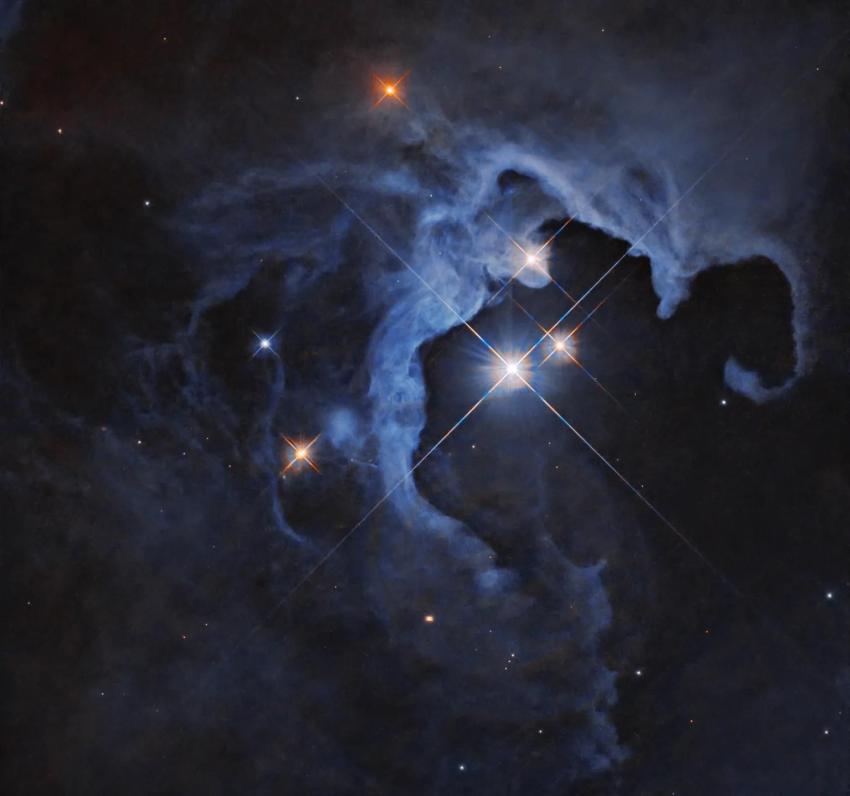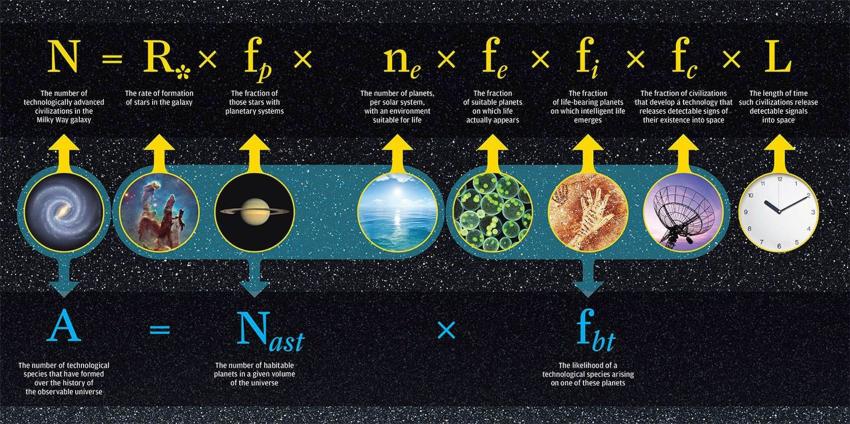The chances of intelligent life emerging in our Universe – and in any hypothetical ones beyond it – can be estimated by a new theoretical model which has echoes of the famous Drake Equation.
This was the formula that American astronomer Dr Frank Drake came up with in the 1960s to calculate the number of detectable extraterrestrial civilisations in our Milky Way galaxy.
More than 60 years on, astrophysicists led by Durham University have produced a different model which instead focuses on the conditions created by the acceleration of the Universe's expansion and the amount of stars formed.
It is thought this expansion is being driven by a mysterious force called dark energy that makes up more than two thirds of the Universe.
What is the calculation?
Since stars are a precondition for the emergence of life as we know it, the model could therefore be used to estimate the probability of generating intelligent life in our Universe, and in a multiverse scenario of hypothetical different universes.
The new research does not attempt to calculate the absolute number of observers (i.e. intelligent life) in the universe but instead considers the relative probability of a randomly chosen observer inhabiting a universe with particular properties.
It concludes that a typical observer would expect to experience a substantially larger density of dark energy than is seen in our own Universe – suggesting the ingredients it possesses make it a rare and unusual case in the multiverse.
The approach presented in the paper involves calculating the fraction of ordinary matter converted into stars over the entire history of the Universe, for different dark energy densities.
The model predicts this fraction would be approximately 27 per cent in a universe that is most efficient at forming stars, compared to 23 per cent in our own Universe.
This means we don't live in the hypothetical universe with the highest odds of forming intelligent life forms. Or in other words, the value of dark energy density we observe in our Universe is not the one that would maximise the chances of life, according to the model.
Dark energy's impact on our existence
Lead researcher Dr Daniele Sorini, of Durham University's Institute for Computational Cosmology, said: "Understanding dark energy and the impact on our Universe is one of the biggest challenges in cosmology and fundamental physics.
"The parameters that govern our Universe, including the density of dark energy, could explain our own existence.
"Surprisingly, though, we found that even a significantly higher dark energy density would still be compatible with life, suggesting we may not live in the most likely of universes."
The new model could allow scientists to understand the effects of differing densities of dark energy on the formation of structures in the Universe and the conditions for life to develop in the cosmos.
Dark energy makes the Universe expand faster, balancing gravity's pull and creating a universe where both expansion and structure formation are possible.
However, for life to develop, there would need to be regions where matter can clump together to form stars and planets, and it would need to remain stable for billions of years to allow life to evolve.
Crucially, the research suggests that the astrophysics of star formation and the evolution of the large-scale structure of the Universe combine in a subtle way to determine the optimal value of the dark energy density needed for the generation of intelligent life.
Professor Lucas Lombriser, Université de Genève and co-author of the study, added: "It will be exciting to employ the model to explore the emergence of life across different universes and see whether some fundamental questions we ask ourselves about our own Universe must be reinterpreted."
Drake Equation explained
Dr Drake's equation was more of a guide for scientists on how to go about searching for life, rather than an estimating tool or serious attempt to determine an accurate result.
Its parameters included the rate of yearly star formation in the Milky Way, the fraction of stars with planets orbiting them and the number of worlds that could potentially support life.
By comparison, the new model connects the rate of yearly star formation in the Universe with its fundamental ingredients, such as the aforementioned dark energy density.
The study, which was funded by the European Research Council and also involved scientists at the University of Edinburgh and the Université de Genève, has been published today in Monthly Notices of the Royal Astronomical Society.
Media contacts
Sam Tonkin
Royal Astronomical Society
Mob: +44 (0)7802 877 700
press@ras.ac.uk
Dr Robert Massey
Royal Astronomical Society
Mob: +44 (0)7802 877 699
press@ras.ac.uk
Scientific contacts
Dr Daniele Sorini
Durham University
Images and captions
Stars in universes of different dark energy densities
Caption: How the same region of the Universe would look in terms of the amount of stars for different values of the dark energy density. Clockwise, from top left, no dark energy, same dark energy density as in our Universe, 30 and 10 times the dark energy density in our Universe. The images are generated from a suite of cosmological simulations.
Credit: Oscar Veenema
Note: The simulations were run on the Cosma@DiRAC supercomputer in Durham as part of the EAGLE project (J. Schaye et al., 2015, Monthly Notices of the Royal Astronomical society, Vol. 446, p. 521), and were first presented by L. A. Barnes et al. (2018) in Monthly Notices of the Royal Astronomical Society, Vol. 477, p. 3727.
Caption: This Hubble Space Telescope image captures a triple-star system, which can host potentially-habitable planets. Our nearest stellar neighbour, the Alpha Centauri system, includes three stars.
Credit: NASA, ESA, G. Duchene (Universite de Grenoble I); Image Processing: Gladys Kober (NASA/Catholic University of America)
Caption: The Drake Equation, a mathematical formula for the probability of finding life or advanced civilisations in the Universe, as revised by two University of Rochester researchers in 2016.
Credit: University of Rochester
Further information
The paper ‘The impact of the cosmological constant on past and future star formation’, by Daniele Sorini, John A. Peacock and Lucas Lombriser, has been published in Monthly Notices of the Royal Astronomical Society. DOI: 10.1093/mnras/stae2236.
The Drake Equation's parameters in full are:
R* = the rate of yearly star formation in the Galaxy
fp= the fraction of stars with planets orbiting them
fg= the fraction of stars that could support habitable planets
ne = the number of planets that can potentially support life (per star with planets)
fl = the fraction of planets that actually develop life at some point
fc= the fraction of civilisations that emit detectable signs of their presence
Notes for editors
About the Royal Astronomical Society
The Royal Astronomical Society (RAS), founded in 1820, encourages and promotes the study of astronomy, solar-system science, geophysics and closely related branches of science.
The RAS organises scientific meetings, publishes international research and review journals, recognises outstanding achievements by the award of medals and prizes, maintains an extensive library, supports education through grants and outreach activities and represents UK astronomy nationally and internationally. Its more than 4,000 members (Fellows), a third based overseas, include scientific researchers in universities, observatories and laboratories as well as historians of astronomy and others.
The RAS accepts papers for its journals based on the principle of peer review, in which fellow experts on the editorial boards accept the paper as worth considering. The Society issues press releases based on a similar principle, but the organisations and scientists concerned have overall responsibility for their content.
Keep up with the RAS on X, Facebook, LinkedIn and YouTube.
About Durham University
Durham University is a globally outstanding centre of teaching and research based in historic Durham City in the UK. We are a collegiate university committed to inspiring our people to do outstanding things at Durham and in the world.
We conduct research that improves lives globally and we are ranked as a world top 100 university with an international reputation in research and education (QS World University Rankings 2024).
We are a member of the Russell Group of leading research-intensive UK universities and we are consistently ranked as a top 10 university in national league tables (Times and Sunday Times Good University Guide, Guardian University Guide and The Complete University Guide).
For more information about Durham University visit: www.durham.ac.uk/about/




